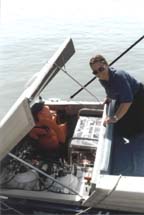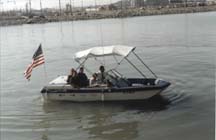Looking For Answers To Wake And Emission
Questions As High-Speed Ferries Solve Traffic Congestion Problems
 |
| Mary
Frances Culnane of WTA inspects the boats hydrogen tanks and fuel
cell. |
By, Wes Starratt, PE, Senior Editor
Long ago, we learned that
for every goal there is a price to be paid and that every
achievement creates problems that must be solved. In the case of
high-speed catamarans, two of the major problems are shoreline erosion
caused by vessel wake and diesel emissions.
The Washington State
Wake Problem
Washington State Ferries,
with its 29-boat fleet, is the largest ferry system in the United
States. For many years it has operated slow automobile/passenger ferries
between Bremerton and the City of Seattle. But, as the number of
commuters grew, the demand for high-speed passenger ferries increased,
and Dakota Creek Industries of Anacortes, Washington, was commissioned
to build two high-speed catamarans for the service: the 143-ft, 350
passenger Chinook in 1998 and her sister ship, the Snohomish,
in 1999. Each had two diesel engines powering water jets to achieve a
speed of 38 knots (almost 44 miles per hour). Commute time was reduced
to 30 minutes, and the passengers were happy.
With twin hulls and low
draft, these boats create much less wake than comparable single-hull
vessels, but with the high levels of energy generated from the higher
speeds, wake proved to be a surprisingly significant problem in certain
areas.
Between Bremerton and
Seattle, there is a 2 ½ mile long, relatively shallow and narrow strait
of water called Rich Passage. There, waterfront property owners were not
happy because the ferries were causing erosion along the shoreline.
Washington State Ferries slowed its boats through the passage and, at
the same time, instituted a study that showed no erosion in areas where
there are natural beaches, but erosion only where the shore has been
armored by bulkheads. Nevertheless, legal action by property owners
brought the matter to a head, resulting in a permanent reduction of the
speed of the ferries through Rich Passage and an increase of the commute
time from 30 to 40 minutes (still better than the 65 minutes the auto
ferry takes). Now the property owners are happy, but the commuters are
not as happy as they once were.
Reduced speed appears to
have provided an immediate answer to the problem, but, for long term
solutions, marine architects have gone back to their drawing boards.
Longer, more slender hulls, perhaps made of lightweight composites may
reduce the problem in future high-speed ferry designs.
Critical Wake Problems
in Venice Lead to Low Emission Propulsion Systems
For many years it has been
claimed that glorious Venice is slowly sinking into the sea. That may be
the case, but, astute eyes have also pointed to the critical erosion of
building foundations along the canals as a major problem. Some have
said, that "we will have to wait until one of our palazzi comes
crashing into a canal before we do something about the critical wake
problems created by the multitude of boats on our canals." Among
the boats are more than 100 vessels of 180-210 passenger capacity for
public transport. Hardly high-speed ferries, these water buses travel at
speeds not exceeding 10 knots. But, their number and frequency and the
number of privately-operated boats on the canals are creating a major
wake problem on the canals of Venice.
 |
| All
aboard for a trial run of the fuel-cell powered water taxi in
San Francisco Bay. |
So, two years ago, a group
of Italian, Dutch, and German organizations got together to establish
the LIUTO (Low Impact Urban Transport water Omnibus) project to develop
a prototype boat for public urban transport. The primary objective was
to reduce wave and wash generation by improved hull design and the use
of lightweight composite materials. Reduced diesel emissions have also
been achieved.
The twin-propeller
propulsion system developed for the prototype boat is operated by two
electric motors powered by battery packs that are, in turn, charged by a
diesel generator running at a constant speed. Low fuel consumption and,
at the same time, low emissions are achieved by the operation of the
diesel engines at a single optimum efficiency level. Such hybrid
diesel-electric power systems, although more costly to build, might find
use in our high-speed ferries because of their fuel efficiency and low
diesel emissions.
Solving Emission
Problems by Fuel Cells and Other Means
While considerable
development is taking place to increase the efficiency and decrease the
emission of diesel engines, considerable effort is being made to develop
other low- emission propulsion systems for ferries, including turbines
operated on natural gas or hydrogen and hydrogen fuel cells.
But, fuel cells are not
new. The idea of combining hydrogen and oxygen to produce electricity
and a harmless emission in the form of water goes back over one hundred
years. However, the technology didn’t catch on until NASA started
using modern fuel-cell units to power spacecraft and provide drinking
water for astronauts.
The idea of using fuel
cells to power boats and ferries is just beginning to dawn, and early in
October, the first fuel-cell-operated water taxi was demonstrated on San
Francisco Bay by DCH Technology, Inc. Only 18 ft long and capable of
carrying up to nine passengers at a speed of 5 knots, the water taxi
would be capable of providing services in calm water such as the Oakland
Estuary, Lake Tahoe, or Newport Beach Harbor where it has already been
tried out. Since the boat doesn’t have a name, let’s call it Heidi
in honor of Water Transit Authority’s Heidi Machen.
Heidi’s 1-kw
hydrogen fuel-cell generates electricity that charges batteries that, in
turn, provide power to the boat’s 10-hp outboard electric motor. The
hydrogen used to power the fuel cell is contained in two compressed
hydrogen tanks.
Funding for Heidi’s
demonstration was provided by the Air Resources Board of the California
Environmental Protection Agency, which stated that the purpose of the
program is "to execute a low cost maritime hydrogen transportation
program in parallel with the State of California’s efforts to promote
hydrogen and fuel cell technologies in the automobile industry. The
agency’s executive officer, Michael P. Kenny, stated that, "We
believe that the best interests of the State of California will be
served by having the State fund DCH’s conversion of the Hydrogen Water
Taxi to a hybrid fuel cell powered design, whereby the environmental
benefits of zero emission hydrogen fuel would be mated with the superior
operating efficiencies of a DCH fuel cell power plant.
"The numerous coastal
and inland waterways of the state are popular places for a large and
growing number of electric powered motor craft. These electric powered
vessels are, like most electric vehicles, limited in range by the
storage capacity of their batteries. DCH therefore decided … to extend
the operating range of such watercraft by using a small on-board fuel
cell to recharge the boat’s batteries in a quiet and environmentally
friendly manner. Examples of where this technology can be used in the
near term are abundant. Newport Beach Harbor, for example, is the home
of over 1,000 electric powered recreational watercraft."
Today it’s a nine-passenger water taxi,
perhaps someday fuel-cell technology may advance to the point where it
will be capable of powering larger boats in an environmentally friendly
manner. Meantime, further progress can be expected in reducing the wake
created by high-speed catamarans and by improved diesel engine
technology. Yes, progress is being made on two key environmental issues
involving the development of a regional ferry system on San Francisco
Bay.